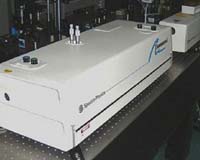 |
Rochester, N.Y. (UPI) Jun 2, 2009 U.S. scientists have used an ultra-powerful laser to turn regular incandescent light bulbs into super-efficient sources of light. University of Rochester (N.Y.) researchers said the laser creates a unique array of nano- and micro-scale structures on the surface of a regular tungsten filament. It's those structures that make the tungsten emit light as bright as a 100-watt bulb, but consume less electricity than a 60-watt bulb. "We've been experimenting with the way ultra-fast lasers change metals, and we wondered what would happen if we trained the laser on a filament," Associate Professor Chunlei Guo said. "We fired the laser beam right through the glass of the bulb and altered a small area on the filament. When we lit the bulb, we could actually see this one patch was clearly brighter than the rest of the filament, but there was no change in the bulb's energy usage." The key to creating the super-filament is an ultra-intense beam of light called a femtosecond laser pulse. The researchers said the laser burst lasts only a few quadrillionths of a second, but it unleashes as much power as the entire electricity grid of North America onto a spot the size of a needle point. The findings are to appear in an upcoming issue of the journal Physical Review Letters. Share This Article With Planet Earth
Related Links Space Technology News - Applications and Research
 French physicists claim breakthrough in ultra-fast data access
French physicists claim breakthrough in ultra-fast data accessParis (AFP) May 31, 2009 French physicists said on Sunday they had used ultra-fast lasers that could accelerate storage and retrieval of data on hard discs by up to 100,000 times, pointing the way to a new generation of IT wizardry. The research builds on achievements that earned the 2007 Nobel physics prize for Albert Fert of France and Peter Gruenberg of Germany, who ushered in a revolution in miniaturised storage ... read more |
|
| The content herein, unless otherwise known to be public domain, are Copyright 1995-2009 - SpaceDaily. AFP and UPI Wire Stories are copyright Agence France-Presse and United Press International. ESA Portal Reports are copyright European Space Agency. All NASA sourced material is public domain. Additional copyrights may apply in whole or part to other bona fide parties. Advertising does not imply endorsement,agreement or approval of any opinions, statements or information provided by SpaceDaily on any Web page published or hosted by SpaceDaily. Privacy Statement |